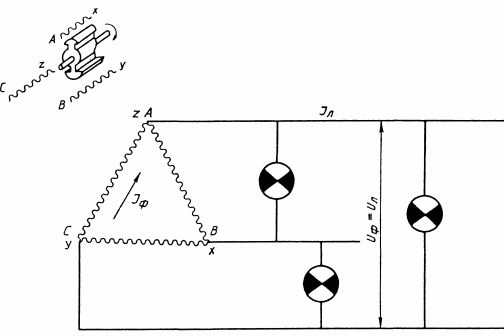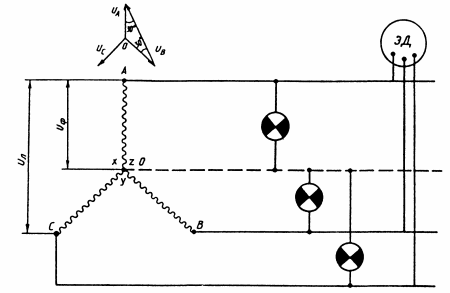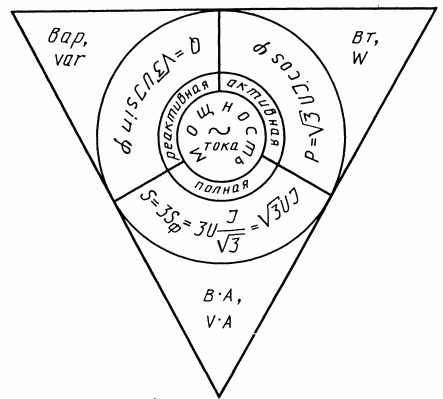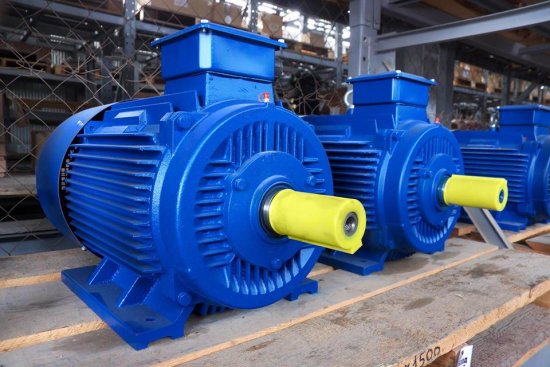Voltage, current and power values for star and delta connections
The great Faraday's discovery of the laws: when a wire crosses the lines of force of a magnetic field, an electromotive force is induced in the wire, causing a current in the circuit into which this wire enters, which served as the basis for the creation of electric generators with a rotating rotor - a magnet. In this case EMF is induced in the stator windings (see — A practical application of Faraday's law of electromagnetic induction).
The resulting voltages can be very different: it all depends on the design of the generator, the number of windings in the stator and how they are connected. In practical electrical engineering, however, the most widespread is the three-phase sinusoidal current system proposed by the outstanding Russian engineer M.O. Dolivo-Dobrovolsky in 1888 (57 years after Faraday's discovery).
Of all multiphase systems, three-phase ones provide the most economical transmission of electrical energy over long distances and allow you to create reliable and easy-to-use generators, motors and transformers.But three windings can be connected in two ways: «triangle» (Fig. 1) and «star» (Fig. 2).

Rice. 1

Rice. 2
Phase is the voltage Uph created by one winding, linear Ul is the voltage between two linear conductors. In other words, phase voltage Whether the voltage between each of the line wires and the neutral wire.
When a symmetrical generator is connected in star, the line voltage is 1.73 times higher than the phase voltage, i.e. Uk = 1.73 • Uph. This follows from the fact that Ul is the base of an isosceles triangle with acute angles 30 °: Ul = UAB = Uf2 cos 30 ° = 1.73 • Uph.
When connected and loaded in star, the corresponding line current is equal to the phase current of the load. If the three-phase load is symmetrical, the current in the neutral wire will be 0. In this case, the need for the neutral wire disappears completely and the three-phase circuit becomes three-wire. This connection is called «star-star without neutral wire». With a symmetrical phase load, the line currents are 1.73 higher than the phase currents, Il = 1.73 • 3If.
When connecting a three-phase generator to a star, two voltages are used, which advantageously distinguishes this connection from a delta connection. But when the load is delta connected, all phases are under the same numerical value of line voltage, regardless of phase resistance, which is important for lighting loads—incandescent lamps.
A three-phase system with a neutral wire is used to supply receivers with two voltages that differ by a factor of 1.73, for example, legs connected to phase voltage and motors connected to line voltage.
The nominal voltage is determined by the construction of the generators and the method of connecting its windings.
Figure 3 shows the relationships that determine the power value for the alternating current circuit in star and delta connections.

Rice. 3.
In appearance the formulas are the same, there appears to be no power gain or loss for these two types of circuits. But don't jump to conclusions.
When reconnected from delta to star, there is 1.73 times lower voltage for each phase winding, although the grid voltage remains the same. The reduction in voltage causes the current in the windings to decrease by the same 1.73 times. And yet — when they are connected in delta, the line current was 1.73 times higher than the phase current, and now these currents are equal. As a result, the line current when reconnected to a star decreases by 1.73 x 1.73 = 3 times.
The new power is indeed calculated by the same formula, but substitutes different values!
When reconnecting an electric motor from a delta to a star and feeding it from the same network, the power developed by this motor is reduced by 3 times. When switching from star to delta windings of generators or secondary windings of transformers, the network voltage decreases by 1.73 times, for example, from 380 to 220 V.
The power of the generator or transformer remains the same because the voltage and current in each phase winding is preserved, even though the current in the line wires increases 1.73 times.When switching the windings of generators or the secondary windings of transformers from delta to star, the opposite phenomena occur: the line voltage of the network increases by 1.73 times, the currents in the phase windings remain the same, the currents in the line wires decrease by 1.73 times.

